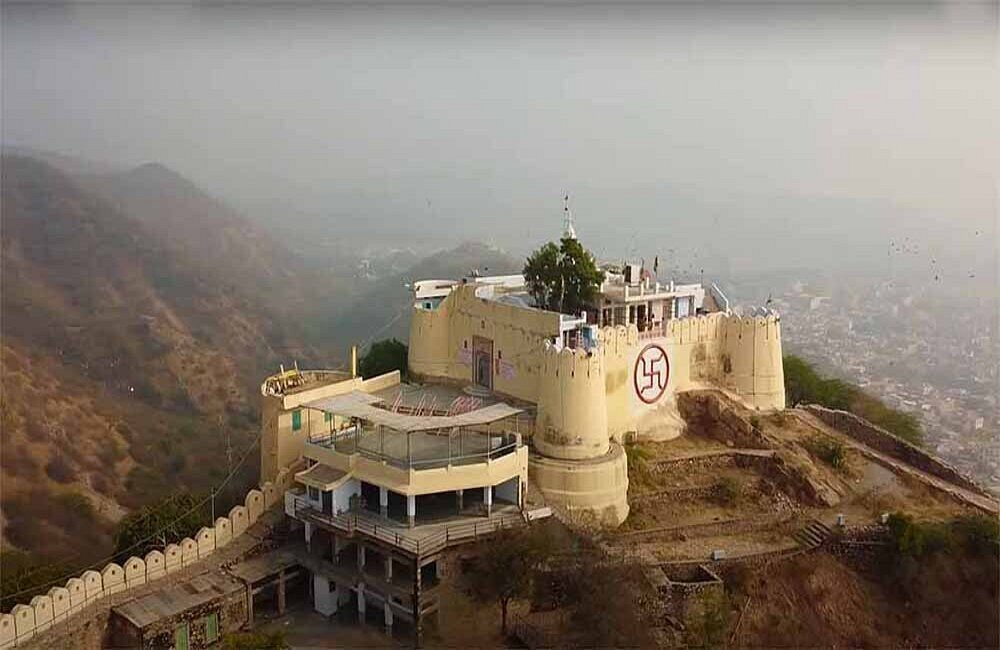Perched on the Aravalli Hills near Nahargarh Fort, Garh Ganesh Temple is one of Jaipur’s most spiritually significant and visually captivating temples. Dedicated to Lord Ganesha, this temple is believed to house a rare idol of the deity in his child form (Purushakriti), without a trunk—something rarely seen in other Ganesha temples across India.
Just a short drive or a steep but rewarding trek from the bustling heart of Jaipur, Garh Ganesh Temple offers a peaceful escape with breathtaking panoramic views of the Pink City below.

Historical Significance of Garh Ganesh Temple Jaipur
Garh Ganesh Temple was established in the 18th century by Maharaja Sawai Jai Singh II, the founder of Jaipur. Legend has it that the temple was consecrated before the construction of the city, and the king performed special rituals to seek blessings from Lord Ganesha for the new capital. Even today, it holds deep cultural and religious significance for the people of Jaipur.
Architecture and Layout
Built in a traditional Rajasthani style, the temple is simple yet majestic. It features:
- An Elevated Position: The temple sits atop a hillock, which requires climbing over 300 steps—worth the effort for the view and spiritual reward.
- Small Sanctum: The inner sanctum (garbhagriha) houses the child form of Ganesha without his trunk.
- Minimal Ornamentation: Unlike other Rajasthani temples, Garh Ganesh is modest in design, focusing more on devotion than grandeur.
- Gates and Stone Arches: The entrance is marked by a traditional gate with stone-carved arches, offering a regal feel.
Religious Importance
The temple is especially revered during Ganesh Chaturthi and Diwali, drawing thousands of devotees. Local priests and residents believe that Garh Ganesh watches over Jaipur and its people, acting as a guardian deity.
Another unique tradition here is that the royal family of Jaipur still performs rituals at this temple, maintaining the connection between the royal legacy and divine protection.
What to Expect When Visiting
- Spiritual Atmosphere: The chants of prayers and bells ringing amidst the serene surroundings offer a peaceful retreat.
- Trek to the Top: A moderate climb through stone steps, with monkeys and birds as companions, leading to panoramic views of Jaipur including Jal Mahal, Amer Fort, and the old city.
- Stunning Sunrises: Early morning visits reward you with golden sunrises over the Pink City.
Timings and Entry
- Opening Hours: 7:00 AM to 12:00 PM and 4:00 PM to 9:00 PM (may vary during festivals)
- Entry Fee: Free
- Photography: Allowed, but avoid during rituals or inside sanctum
How to Reach Garh Ganesh Temple
- By Road: Located around 5 km from the City Palace. Accessible via Brahmapuri or Nahargarh Fort route.
- By Auto/Taxi: Available easily from any part of Jaipur.
- Trekking Option: Start from the base near Nahargarh road and follow the marked stairway.
Nearby Attractions
- Nahargarh Fort: Just a short hike or drive away, known for sunset views.
- Amer Fort: Iconic historical fort, visible from the temple hill.
- Jal Mahal: Scenic palace in Man Sagar Lake, visible from the climb.
- City Palace and Hawa Mahal: Major attractions in the old city.
Travel Tips
- Wear sturdy shoes if trekking up.
- Carry water, especially in summer.
- Visit early morning or late evening for cooler weather and better light.
- Respect temple customs and maintain silence during aarti times.
Conclusion
Garh Ganesh Temple is not just a religious destination—it’s an experience of devotion, nature, and heritage combined. Whether you seek spiritual connection, scenic views, or a peaceful retreat above the city, this temple delivers on all fronts.
If you’re visiting Jaipur, don’t miss the chance to climb to this divine spot that has been watching over the city for centuries. The blessings of Lord Ganesha, paired with the tranquility of the Aravalli hills, make it a soul-refreshing journey.
